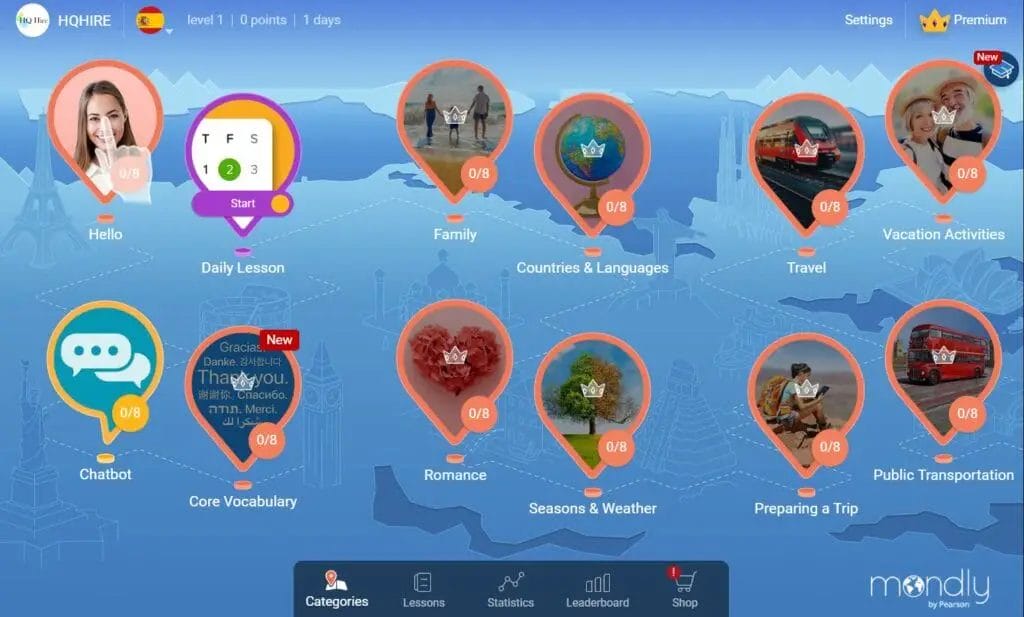10 Top Benefits of Gamification in Education (Why You Should Too)
83% employees who undergo gamified training felt more motivated, more engaged and leads to better learning outcomes.
Bringing gamification into your classroom can have many real-world applications and benefits. Not only it can help to increase engagement, motivate students and make them more excited about learning. Gamification enriches the whole learning experience that improve learning outcomes.
The application of gamification are endless, with top online learning tools offering features that help to implement gamification in learning with just a few simple clicks, more educators are adopting game-based learning for their learners.
KEY TAKEAWAYS
- Gamify your classroom by choosing the right game mechanics can helps students to become more engaged and enhance the eLearning experience.
- Top online course platforms offers gamification features, as gamification provides a simple but highly effective way to improve learning outcome and helping learners to retain more information.
- The impact of gamification increase dopamine release helping students learn faster.
What is Gamification in Learning?
Gamification is the process of using game elements in a non-game context. This includes bringing in game elements and game mechanics into the different learning environment.
With gamification, it transform the way learners learn new information, gamification in learning increases your cognitive development in receiving of new knowledge helping you to retain information in a shorter time frame, improving your learning outcome.
For any educational program to be effective, it must encapsulate and engage a student’s imagination. Gamified learning can do just that.
Top Benefits of Gamification in Education For Learners?
Implementing gamified learning to enhance the e-learning experience is common amount the top educators, with many real-world applications, gamification can help create a better learning experience.
A popular feature offered by the top learning management systems (LMS), gamified learning programs offer many potential benefits such as; promotes motivation, removes boredom, improves material retention and lessens fears of failure, among several others.
In fact, there are so many benefits of using gamification in education, you’d be doing your students a disservice not to use it.
1. Gamification Increases Motivate and Ambition To Win
When you turn your educational materials into a game, it promotes motivation and an ambition to win. Points, progress bars, prizes and rewards mean people will want to accomplish each module or lesson without apprehension.
This is because most people have a natural propensity to accomplish goals and milestones. Playing any kind of game satisfies that inclination. This is particularly useful for younger generations, where getting them to learn material is something akin to drudging through the mud.
There are four major components to this aspect of motivation:
- Immersion: Students discover new and surprising elements to the game through things like role playing, exploration or unlocking “secret” levels. It’s the kind of motivation that continually perpetuates itself.
- Social Influence: Having a social impact can be a great motivating factor in learning. When students can see their scores and how they match up with other students, they can gauge how much more work they want to put into the learning process. Likewise, group efforts in gaming can build teamwork skills.
- Accomplishment: Even though this was part of the discussion above, it’s worth mentioning for the list. Remember, people love to demonstrate their mastery over and excel in challenges. Having a sense of victory in something builds a desire to learn more.
- Practical Application: Putting material into a gaming format means students will be better able to apply that knowledge to practical applications. They’ll be able to see how it works in the real world, which will further motivate them to play more games and learn more information.
2. Gamifying Learning Removes Boredom
Turning lessons into a game not only makes learning fun but it removes boredom. Such a thing is especially true when you have material that’s usually difficult or mind numbing to learn. For instance, if you’re teaching a foreign language, probate law, municipal insurance or other such topic, a game will help change attitudes.
This is because the moment a student finds something boring, they will lose interest and may even stop learning altogether. Therefore, the gamification of your material will be the best way to prevent this.
A great example of how gamification makes learning fun is an app called Mondly, an online language learning App. Anyone can learn a number of different languages. It’s done in a fun way and presented like a video game, which makes remembering things like the alphabet, grammar, sentence structure and other elements far easier to digest.

3. Make Learning Fun Which Equals To Better Retention
The best way for people to remember things is when they’re fun. So, it only makes sense to make your courses and classes as amusing as possible. If the material has many nuances and details for students to remember, putting it into a game-like format will help with recall.
The repetition games provide means the information will ingrain into their memory banks much better than reading a book or listening to a lecture. Also, it doesn’t have to be a video game. You can alter a popular board, card or even an athletic game. For instance, you could use Monopoly to teach about probate law or soccer for atom movement in chemistry.
Gamification exploits the human truism that events and moments are what make an impression. Most people don’t usually remember specific dates, especially if they aren’t applicable to their own lives; such as is the case with learning history. But, people do remember a moment due to the details that unfold.
4. Games Are Addictive
One of the biggest complaints people have against video gamers is their addiction. They’ll play every day for hours on end and, sometimes, without regard to obligations and responsibilities. While you probably don’t want to encourage this by gamifying your classes, you do want to draw on this quality.
By offering points, rewards and goals, it will make the game addictive to students, backed by their motivation. Ergo, learning the material will become addictive for them. When this happens, they’re more likely to remember and retain the information.
Plus, the reward factor actually releases dopamine into the body. The good feeling that people get from this means they’ll want to return for more.
5. Lessens The Fear of Failure
The reason why we learn anything is because of mistakes and failures. Without them, we wouldn’t attain the wisdom necessary to retain knowledge.
But, for many people, failure is a source of great shame and embarrassment. Whatever the reason, it’s the main deterrent in wanting to learn new things and take risks. But, when it becomes a game, this attitude changes the whole learning dynamic.
Not only does gamification make failure an acceptable part of the process, but it also makes it desirable. This helps to alter a person’s attitude and may cause them to embrace it – even providing the grit and resilience required of their own lives. This is what quality education is: when the lesson extends beyond the material into multi-faceted real-life applications.
6. Caters to Various Learning Styles
When you have a classroom of 10 people or more, everyone is going to have a different preference for learning. Some people learn by visuals, others learn by writing, a few learn by listening and yet there are those who learn by doing. In many cases, people have a combination of ways they like to absorb materials.
Therefore, gamification of education can cater to all these various learning styles without too much effort on your part. Plus, you can analyze their results to see which types of games most students see success. This way, you can develop other games to accommodate them for the ultimate in learning.
7. Gamification Improves Cognitive Development Ability
One of the most invaluable things about gamifying education is how it improves cognitive abilities. Several studies over the last decade or so provide strong evidence for this. They promote problem-solving and critical thinking skills while also improving a person’s ability to retain and process information.
One particular study in 2013 looked at educational games and their efficacy on the human mind. They found that it not only enriched a person’s spatial awareness but it also made them faster at information recall. This came along with accurate attention to detail and allocation. Plus, it gave an individual the ability to envision data from several viewpoints.
8. Boosts Engagement
Because games provide a hands-on approach to learning, gamification will boost student engagement with the material. It provides a practical display of the lessons in action, which helps their brain connect the education to real-life situations.
The inherent element of fun means it will be exciting and entertaining too. Therefore, it removes the idea or perspective of learning being an overwhelming or daunting task. This, in turn, will boost engagement while improving their knowledge and skills.
When featuring progress bars, rewards and points, the immediate self-gratification will be at the forefront of students’ minds. There is no substitute for interactivity and gaming in education can do wonders in this regard. It removes that dry “learning” feel, especially for those who have a general aversion to education.
9. Gamification Makes Learning Personal
When someone plays an educational game, it immediately becomes their own personal experience. While it’s good for students to see how they rank against other classmates, the scoring and analytics of their progress gives them something that’s uniquely theirs.
This translates to students setting their own rules, methods and systems for accomplishing and absorbing the material. Of course, this will depend on the game in question, but the basic premise is the same. What’s more, playing games provides real-time feedback and this further galvanizes their personalization.
10. Gaming is Familiar
Because most people are familiar with games, you don’t need to introduce them to the concept. Regardless of whether it’s a video, card or board game, students use these with a kind of instinct. All you have to do is introduce the rules and explain the rewards they’ll receive along with any other plusses.
This means you’ll mitigate ambiguity while also promoting things like motivation and engagement. It empowers students because the game will feel normal and nearly like second nature. Such a thing develops confidence and a sense of control.
Read Also:
- 7 Best Teachable Alternative for Course Creators (Free and Paid)
- LearnWorlds Features: In-Depth eLearning LMS Overview
- ThinkiFic Features: Course Creator’s In-Depth Overview
- 200+ Best Online Course Ideas For New Course Creators of Every Niche (Updated)
- +59 Best Proven Membership Site Ideas to Get Started This Year (Read First)
Join 900+ BUDDIES who are growing their wealth with our weekly Income Newsletter
Antony C. is a dividend investor with over 15+ years of investing experience. He’s also the book author of “Start Small, Dream Big“, certified PMP® holder and founder of IncomeBuddies.com (IB). At IB, he share his personal journey and expertise on growing passive income through dividend investing and building online business. Antony has been featured in global news outlet including Yahoo Finance, Nasdaq and Non Fiction Author Association (NFAA).

